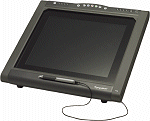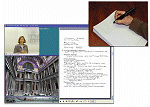Note-taking Cleans the Slate
- By Charlene O’Hanlon
- 10/01/07
When it comes to classroom collaboration, instructors are turning
to new note-taking tools that free them to present dynamically while
allowing their students to listen and interact, instead of scribble.
 TIME WAS, THE ONLY WAY a student could obtain her
instructor's class notes was to furiously copy them off the
board before they were erased— or else procure them
from a classmate, a questionable practice at best.
TIME WAS, THE ONLY WAY a student could obtain her
instructor's class notes was to furiously copy them off the
board before they were erased— or else procure them
from a classmate, a questionable practice at best.
Fortunately, times have changed, and classroom collaboration—
wherein teachers and professors actually
seek out ways to share their class notes with
their students— is now the norm rather than the
exception. Hardware and software offerings
from vendors such as Tegrity and Smart Technologies are making the access to and
exchange of information a good deal easier.
Better Teaching, Better Listening
At Northern Illinois University, instructors and technologists
are testing the classroom collaboration waters with
the Smart Sympodium interactive pen display products.
The DeKalb-based state university last year made the
decision to upgrade its "intelligent" classrooms (which
featured standard multimedia offerings such as projection
systems, CD and DVD players, and document viewers) to
include the interactive Sympodium displays, reports
James Bollenbach, media technical services head at NIU.
"We wanted to expand the use of our presentation
tools, and so we queried the instructors to see what they
wanted," he explains. "One of the things they asked for
was additional annotative capability." Simply put, the
instructors wanted to build upon their existing "static"
Microsoft PowerPoint presentations,
or create altogether new learning plans with the use
of class notes and information collected on the fly.
In response to that need, technologists installed eight
Sympodium tablets in the spring of 2006, with a plan to
install a total of 106 campuswide by the beginning of the
2007-2008 school year. The installations are part of the
NIU provost's Smart Classroom Initiative, which was
designed to provide classrooms with advanced technology
for the enhancement of students' education.
Now, instructor notes can be saved
and sent to the class, allowing
students to focus on listening,
questioning, and interacting.
So far, says Bollenbach, instructors have expressed their
enthusiasm for the new note-taking capability; they are generally
thrilled with the ability to quickly and cleanly annotate
pre-developed lectures, and then send out the annotated
class material to the students. "Many are simply using it to
pull up a white page and utilize that the way they used to use
a chalkboard," says Bollenbach, pointing to a simpler yet
effective method of classroom collaboration.

THE SMART SYMPODIUM enables NIU faculty
to annotate lectures
with information
collected on the fly.
Janet Giesen, instructional design coordinator for NIU's
Faculty Development and Instructional Design Center,
agrees that, for the most part, instructors across the campus are viewing the new classroom collaboration tool with interest.
Though many of them may not have access to the equipment
for a while, says Giesen, they are already seeing the
opportunities for sharing and enhancing communication with
their students.
"They recognize that this brings another
dimension to their teaching," she offers,
pointing out that although the majority of
faculty on campus are already using some
form of interactive software, next to the
new breed of tools, "it's becoming static."
The ability to save their class notes is a
feature instructors are particularly excited
about, Giesen says. "Often, [because a
whiteboard or chalkboard has limited
space], the instructor is writing things down and erasing as
he goes. But the fact that the notes can be saved and sent
to the students is really dynamic," she declares. "It also
lessens the necessity of students to take notes quickly.
Now they can listen and question more, and generally be
more interactive with the instructor and their peers."
Still, she points out, she has had to caution overly zealous
instructors about the dangers of jumping into the new technology
feet first. When they are training on the tools, "I ask the
faculty to first think about whether they really want to use it,
and whether they can [commit to] learning to use it seamlessly
and effectively. Winging it doesn't work with technology,"
she insists.
Clarity Before Discussion
At the Georgia Institute of Technology in Atlanta, Stan Lindsey, professor of
engineering, is using collaborative note-taking tools not
only to enhance his instruction during class, but before
class, as well. Lindsey, who teachers senior- and graduate-level
design courses, uses the Tegrity Notes product in
conjunction with the Tegrity Campus class capture system,
to record a streaming lecture that students must view prior
to class. They then take a timed quiz online before class
begins. He uses the tools in this manner, he says, because
"then class is more interactive, and students don't have to
concentrate so much on taking notes. They can focus more
on being a part of the discussion."
The professor's approach may be unique, but there's a
method behind it: Lindsey acquired his knowledge of collaborative
learning in the business world as owner of a
structural engineering firm— a career he pursued before
becoming a professor in the discipline.
"I had a lot of experience teaching people, and I found
that they liked streaming lectures. They
could see them whenever they wanted
to," he explains.

AT GEORGIA TECH, instructors can record a streaming lecture for students
to view prior to class; then using Tegrity Notes, students can attach their
own notes to the lecture both prior to and during the actual class.
Now in class, "Rather than furiously
taking notes while I stand up and
lecture," Lindsey says, "students can
attach their notes and my own to the
lecture, in their own time. That way,
during class they can ask about the
things they didn't understand in the
streaming lecture, and once they've
gotten the answers they need, they
can attach those notes as well, so that the part of the lecture
that confused them previously now makes sense. They
come in prepared and I can then quiz them before we even
get started on the lesson. And that really gets their attention,
because the online tests count for a substantial portion of
their grades."
While it may seem like a lot of pressure, Lindsey says the
students like the setup. "They love it, actually. They can view
the lesson multiple times, at their convenience, and they're
not pressed to take tough notes."
Note-taking and testing designed to leave the academic
forum open for free exploration? What a novel idea.